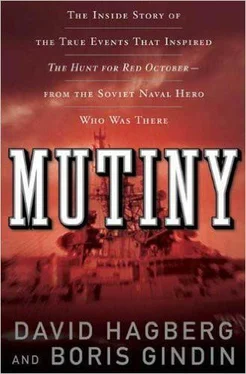At that moment he feels like slamming his fist in someone’s face. But Gindin is an officer and a gentleman.
Gindin has his sailors line up at attention and demands to know who started diesel number three and why. No one speaks up.
Gindin asks again, and still not one of his sailors speaks up.
Gindin has to go down the line, looking each sailor in the eye as he asks the same questions: “Did you start the engine, and if you did, why?”
Finally Andrey Bazhanov looks down and nods. “I did it,” he says.
Gindin holds himself in check. “I gave orders not to start diesel number three. Why did you disobey?”
“I knew something was wrong with the engine. I just wanted to see how it would work if it was started.”
Gindin reads the sailor the riot act. Bazhanov was young, he was bored, and he wanted to do something, anything, to make his day a little more interesting. They’re all warned that if something like this ever happens again, the guilty sailor will be court-martialed. Probably sent to prison!
Everyone learned a lesson that day. Gindin’s sailors learned that they were to obey orders at all times, and Gindin learned that he has to keep his ear to the ground and his eyes open so that he will know what is going on with his crew and his ship.
Another link has been forged in a chain that binds them together. Gindin does not report the incident to the captain. This hiccup in BCH-5 will stay there, and the sailors appreciate it.
The little incident will come back to pay big benefits at the very end of that same rotation when the Storozhevoy returns to his base at
Baltiysk. According to the engine logs, all five diesels have completed their scheduled life spans. They are to be replaced in the fitting-out process. This job, however, has to be done before Gindin or any of his sailors can go on leave. They’ve been on rotation for six months; everyone just wants to get off the ship, no matter how much they may love him, and go home.
Gindin reports to the assistant division commander who is in charge of all mechanical equipment. Replacing the five diesels should take one month, maybe a week or two more. It’s how long other crews have needed to get the job done.
“So, Senior Lieutenant, you may begin scheduling your crew’s leaves in thirty to forty-five days,” the guy says with a smile. “Good luck.”
Back aboard, Gindin calls a meeting with the six sailors responsible for the diesels to tell them that they can go on leave only after the diesels have been replaced. The sooner the job is finished, the sooner they can go home.
Everyone is eager to get started. This is a very well-motivated bunch of young men.
In order to remove a diesel engine from the ship, all of its supporting systems need to be disconnected, which includes the fuel lines, oil lines, air lines, and electrical cables. Gindin organizes a series of wooden crates in which the parts from each support system, for each diesel, will be labeled and stored after they have been thoroughly cleaned and checked.
Once that job is started, Gindin marches over to the building where the replacement diesels are stored and holds out a bag containing three bottles of spirt, the nearly universal Soviet naval scrip, in front of the depot manager.
“I want my five diesel engines delivered without delay,” Gindin says. “Is this possible?” Usually it takes three to four weeks for a delivery.
The manager grabs the bag and nods enthusiastically. “Lieutenant, if you give me twenty-four hours’ notice, you will have your diesels.”
Seven days later, the old diesels have been completely disconnected, and Gindin calls the depot manager, who is as good as his word. The next day his crew shows up with a lifting crane to remove the old engines and deliver the new ones.
Seven days after that, all the supporting systems have been reconnected and the five new diesels have been run up and checked out.
Gindin reports back to the assistant division commander that the work is done, but the guy doesn’t believe it.
“That’s impossible,” he sputters.
“Please, sir,” Gindin says, smiling. “Stop by yourself and check our work.”
Already Gindin has the reputation at Baltiysk as the young senior lieutenant who is almost always walking around with a grin on his face. The assistant division commander doesn’t have to put up with this kind of shit. “In the first place, Lieutenant, it takes twice that long just to get new diesels delivered, let alone installed.”
The grin on Gindin’s face widens. He can’t help himself. This is fun. “I insist, sir. Come see for yourself.”
The assistant division commander does just that, and he can’t believe his eyes. The five diesels have been installed, and they are running perfectly. Without another word he signs leave papers for Gindin and his sailors and storms off the ship and back to his office, wondering where the hell he went wrong.
The loyalty of Gindin’s crew is the barrel of still another gun that Gindin is looking down facing Zampolit Sablin in the midshipmen’s dining hall. The Storozhevoy may be his master, but his crew is the ship’s servant and Gindin needs to take care of both in any way he can.
But the situation is more complex than that. It’s not the ship, officers, and crew as separate entities that must work and live together. They’re three legs of a triangle, ship-officers-crew, that function together as a single entity. It’s another of the relationships that most civilians can’t appreciate at the gut level but that anyone who has ever served aboard a warship understands immediately.
At this moment on an early November evening aboard the Storozhevoy, faced with such a monumentally impossible decision, Gindin can perhaps be forgiven if he allows his mind to drift a little. He’s barely treading water in a monstrous ocean. In the troughs all he can see is black water in which he will surely drown. But at the tops of the waves he catches tantalizing glimpses of the base at Baltiysk, near enough to the home of the Baltic Fleet at Kaliningrad to be a safe haven.
The fleet, which consists of nearly forty major surface warships, more than three hundred small combat vessels, 150-plus auxiliaries, two dozen submarines, 250 navy aircraft, and the one naval infantry brigade that Admiral Gorshkov promised each unit, is a formidable power. And yet the town of Baltiysk, where the bulk of the fleet put in after each rotation, is not much more than a village that opens to the Gulf of Gdansk and the Baltic.
Gindin recalls that the base was always busy with ships coming and going. While they were in port they were tied alongside four long docks and were connected to the shore by not only the bow and stern and spring lines but also lines and hoses that supplied electricity, potable water, and fuel.
The base always stank of oil and foul bilge water drained overboard. But everyone felt a sense of invincibility here. At sea you were sometimes surrounded by the enemy—American aircraft carriers, Italian submarines, the bastard German destroyer that had tried to crowd them—but at Baltiysk you were home free. Safe.
The main street of the base is tree lined in the summer, pleasant with buffets and little shops where sailors can buy milk and cookies and cigarettes and other homely little things.
And there is soccer competition. Eight ships in the Storozhevoy’s Bpk division have formed a league. They play on a field near the docks, with benches on the sidelines for the fans. Gindin and Firsov are among the men representing their ship, and whenever they play, Potulniy and Sablin and most of the other officers not on duty or away from the ship come down to the field to give their noisy support.
Читать дальше












